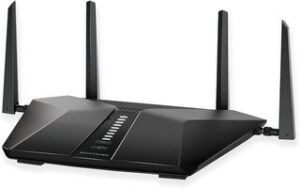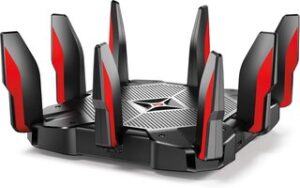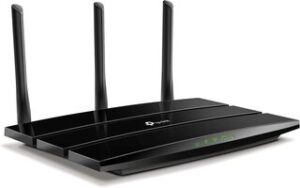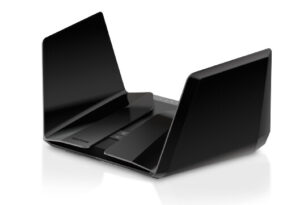Our top AT&T router recommendation is the Nest Wi-Fi Pro
The Best Routers to Choose for AT&T Internet
If you’re an AT&T Internet service customer or want to become one, you’ll need an AT&T-compatible router.
While you can rent a router from AT&T, we at Reviews.org highly suggest buying your own to ensure it suits your specific needs.
We recommend a variety of AT&T routers, including the Nest Wi-Fi Pro, two NETGEAR routers, and two TP-Link routers.
Amazon.com List Prices (as of 10/17/2023 11:00 MST)
What to look for in an AT&T-compatible router
AT&T allows you to rent its compatible router, but that one won’t necessarily be the best fit for your needs. We think that in most cases, it’s better to choose your own router.
All the routers we chose should work with any AT&T DSL or fiber plan, so you don’t have to worry there.
Router features can vary dramatically, so we’ve compiled a list of some features you may want to consider when choosing yours.
Router features to consider for AT&T internet
- Number of bands
- Number of streams
- Download speed capabilities
- Wi-Fi coverage area
- Mesh capabilities
- Parental controls
- USB ports
- LAN ports
- Gaming or streaming features
The routers we recommend are either dual-band or tri-band. Traditionally, routers with multiple bands use a combination of 2.4 GHz and 5 GHz—although one of our recommendations also has a 6 GHz band.
Each band has multiple streams, aka lines of communication, between devices and routers. More streams theoretically equals faster Wi-Fi; however, not every router shares its stream number, and technically, you don’t need to know it as long as you know the maximum download speed.
Each router covers a certain square footage, so make sure your chosen router will cover your home. If it doesn’t, you’ll need to pick a different device, unless the router works with a mesh system. With mesh, if you buy an additional router of the same model and place it strategically in your home, you’ll double the square footage coverage and get better Wi-Fi service to boot.
If you have young’uns in your house, you may want parental controls. Different brands have different control abilities, but some models allow features like temporarily pausing the internet, tracking website use, tracking device use, and blocking certain content.
Not everyone needs USB ports, but if you want to share files across multiple devices connected to your Wi-Fi, plugging a USB directly into your router is a great way to disseminate. A USB can also create a makeshift cloud storage for your router.
An LAN port/Ethernet port lets you connect devices directly to your router versus going the wireless route. Most people wouldn’t use this feature daily, but if you’re in the middle of something crucial and afraid of your Wi-Fi connection faltering, that direct connection is a lifesaver.
Finally, if you’re an avid gamer or streamer, you want to look for gaming or streaming features. That could include many things, but we recommend a Dynamic Optimization Engine, Airtime Fairness, and Smart Control. We’ll talk more about these as they come up in the article.
Nest Wi-Fi Pro: Best mesh system
Nest Wi-Fi Pro is an updated version of the Google Nest Wi-Fi mesh system, and it’s better than ever! A mesh system using these routers covers a ton of ground in your home. Plus it comes with built-in Google Assistant and several different colors to choose from.
One of the Nest Wi-Fi Pro routers provides approximately 2,200 square feet of coverage, but multiples work together as a mesh. So, if you get a second router, you’ll have a two-router mesh that covers 4,400 feet, and so on. For this reason, Nest Wi-Fi Pro is an excellent choice for larger homes—you can get massive coverage by adding more routers to your network.
Each router has three bands: 2.4 GHz, 5 GHz, and the newfangled 6 GHz. Each also reaches a maximum speed of 5.4Gbps (400 more Mbps than the speediest AT&T Internet plan will reach).
Another benefit of this mesh system is that it’s “self-healing.” If one router has connection issues, the other can pick up the slack. Although you might see some lag when that happens, you’re unlikely to encounter a total internet interruption.
Also, if you use other Nest or Google products in your home, you’ll be pleased to know that Google Assistant is built right into these routers. They essentially double as a router–smart speaker combo, so you can get your Wi-Fi hookup while asking Google about the weather.
Finally, the tricky thing about a mesh system is that you’ll need to put routers in a few locations throughout your home to take full advantage of its coverage. So you may be unable to relegate your Nest Wi-Fi Pros to the basement or a coat closet like you would most routers.
But the good news is that these Nest Wi-Fi Pro routers are clean and cute-looking and come in four appealing colors: fog, snow, linen, and lemongrass. There are no eyesores with Nest Wi-Fi Pro.
NETGEAR Nighthawk RAX50: Best parental controls
If you’re leery of what your kids might get up to online, the NETGEAR Nighthawk 8-Stream WiFi 6 Router (RAX50) is definitely for you. The included parent controls let you provide your children with custom, controlled internet access.
First off, the basics. The RAX50 covers 2,500 square feet, has a dual band, reaches 5.4Gbps in download speed, and uses Wi-Fi 6 (which is a fancy way of saying it includes all the latest Wi-Fi technology).
It also has four Ethernet ports to plug devices directly into your router, plus a USB port for cloud storage.
But the main draw is the extensive parental controls. The RAX50 looks intimidating, but luckily, you don’t have to interact with the hardware to access the NETGEAR Smart Parental Controls. You can find those through the Nighthawk app.
The primary parental controls allow you to create individual user profiles. And, like some powerful Wi-Fi wizard, you can pause the internet connection during dinner or chore time
If you pay extra for Smart Parental Controls Premium at $7.99 a month or $69.99 a year, another world of features will open up. You’ll be able to:
- See device usage
- See website history
- Assign time limits through the My Time app
- Filter content
- Create custom bedtime schedules
- Track and reward good online behavior
Data effective as of 10/17/2023. Offers subject to change.
TP-Link Archer C5400X: Best for gaming
If you’re a gamer, you’ll love the TP-Link AC5400 Tri-Band WiFi Gaming Router (Archer C5400X), Archer C5400X for short (for obvious reasons). This baby can handle high traffic, making it an optimal choice for serious and non-serious gamers alike.
There are a few features that help the C5400X handle high traffic. First, it has a tri-band—one 2.4 GHz and two 5 GHz bands. TP-Link says the 2.4 GHz band can handle 1,000Mbps while the other two can each handle 2,167Mbps. (For those wondering, that’s a total download speed of 5,334Mbps, which TP-Link advertises as “blistering.”.)
Second, the C5400X includes something special called a Dynamic Optimization Engine, which constantly works out the most efficient ways to deal with the traffic load. Pretty neat, huh?
Finally, this router uses Airtime Fairness. This feature keeps older devices from slowing all newer, faster devices down.
All of this helps the router handle high traffic (aka games) alongside regular internet and smart home use.
What else is there to know about this device? It’s compatible with Alexa, so you can give Alexa some router-related commands, such as “Turn on the guest network.” And it has eight LAN/Ethernet ports to connect your gaming devices directly to the internet, no wireless required.
We will admit that this router is unique looking. It looks like it’s from Barad-dûr, but that’s part of the fun, right? Maybe keep it out of sight if its appearance ruins your decor.
TP-Link Archer A8: Best budget router
If you can’t see yourself dropping over $100 on a router, we present the TP-Link AC1900 Smart WiFi Router (Archer A8). It’s highly affordable, but it has many great features regardless.
The Archer A8 is the most inexpensive router we recommend . It only gets up to 1,900Mbps, but it covers 3,500 square feet (and it’s also compatible with TP OneMesh if you’d like a mesh system in the future). It also has a dual-band router, 4 LAN ports for Ethernet access, and two USB ports for cloud storage and file sharing.
Plus, this router has a lot of great features. It has a Smart Connect feature to ensure each device is on the optimal band, Airtime Fairness like the Archer C5400X, and parental controls like the RAX50. There’s also a TP-Link Tether app to help you manage everything more conveniently. Not bad for less than $100, amirite?
Apart from the Archer A8 being a good money saver, we suggest it for AT&T customers who use or want to switch to AT&T Internet Air. These plans have slower speeds than other AT&T offerings and don’t need the multi-gigabit functionality.
Not going to say the exact cost to make this easier to update in the future.
NETGEAR Nighthawk RAX120: Best for AT&T Fiber plans
AT&T offers two different internet connections: DSL and fiber. If you have a DSL plan, any of these routers will do the trick. But if you have a fiber plan, you might want the NETGEAR Nighthawk WiFi 6 Router (RAX120) to harness the full power of those fiber-optic cables. Just know that the RAX120 costs as much as the router you would order at an expensive steakhouse … that serves routers … don’t think too hard about this metaphor.
The powerful RAX120 has a dual band with six streams each, with a total download speed of 6.000Mbps (6Gbps). That’s the fastest download speed of any of the routers we recommend. It also covers 3,500 square feet and has five Ethernet and two USB ports.
Like the C5400X, the RAX120 works with Alexa, so you can easily connect it to your smart home system. And like the Archer A8, it uses Smart Connect to optimize its band traffic. Oh, and it comes with a free trial of NETGEAR Armor for extra security—just in case baddies are trying to gain access to your internet.
The RAX120 touts itself as a Wi-Fi 6 router, meaning, again, that it features the most recent wireless technology. But it’s supposedly only effective for 30 devices at a time.
Although we suspect that’s not actually the case—6Gbps is an astonishing internet speed and should allow for more connectivity than that—if you’re concerned about the connectivity abilities, you may want to go for a router that works with unlimited devices.
And the cost! Oh, that cost. It’s hard for us to justify a router that costs several hundred dollars, especially when you can get one that runs at four-fifths of the RAX120’s speed for a portion of the price.
Recap: Best AT&T internet routers for home routers
Let’s do a little refresh on which routers we recommend if AT&T is your internet provider.
- The Nest Wi-Fi Pro has an excellent mesh system to cover a large home and self-heal your network.
- A NETGEAR Nighthawk RAX50 helps you monitor your kids’ internet use and activities.
- The TP-Link Archer C5400X combines several features to create an optimal Wi-Fi network for gaming.
- If you don’t want to spend much money, a TP-Link Archer A8 still provides an excellent network experience at a lower cost.
- To optimize your AT&T fiber plan, consider the powerhouse NETGEAR Nighthawk RAX120.
Methodology
When picking our top routers for AT&T connectivity, we mainly considered:
- Price
- Max download speed
- Wi-Fi coverage area
- Mesh capabilities
- Parental controls
- Gaming or streaming features
Other features, like the number of bands or ports, either weren’t as important in our calculations or were part of other items on our list.
While we didn’t get a chance to test all these routers, crunching numbers (like coverage area and download speed) gave us a good idea of how well they perform. We also looked at Amazon reviews to ensure all these devices have good ratings.
Catherine McNally also contributed research to this article.
Related Articles











